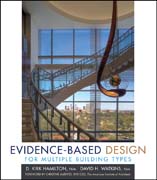
D. Kirk Hamilton, FAIA, and David H. Watkins, FAIA have written this enlightening book showcasing the process and products of evidence-based design, a practice that should be in the top drawer of every architects toolkit. Evidence-based design sounds a clarion call for more rigor in the knowledge-based practice of creating the built environment, as well as stronger collaboration and sharing of knowledge between client and designer. I cant think of two people morequalified to have taken on this topic. -- from the Foreword by Christine McEntee, Executive Vice President/CEO, The American Institute of Architects Evidence-based design, which bases design decisions on the best available current research evidence, is gaining traction among architects. Expanding the field from its origins in healthcare to other building types such as education, criminal justice, commercial, industrial, and places of worship, this book introducesdesign professionals to the concept of evidence-based design and its use in the creation of high performance environments. It focuses on the methods by which design professionals and their clients can create better buildings by critically interpreting the implications of credible research and careful observation of completed projects. Drawing a direct link between evidence and application, the authors provide examples of credible research that supports evidence-based design are presented, as well as specific applications and case study examples. INDICE: Foreward By Chris McEntee. Acknowledgements. ntroduction. PART I: THE CASE FOR EVIDENCE-BASED DESIGN. Chapter 1: What is Evidence-Based Design?.Chapter 2: Precedent-Based Professions & Transforming Architecture. Chapter 3: The New Practitioner. Chapter 4: Sustainable Design is Founded on Evidence (Lia Johnson). PART II: EVIDENCE-BASED DESIGN FOR BUILDING TYPES. Chapter 5: Evidence-Based Medicine and Healthcare Design. Chapter 6: Evidence in the Designof Learning Environments (Alejandro Iriarte Dent). Chapter 7: Evidence and Data in the Design of Workplace Environments. Chapter 8: Data Drives the Design of Retail Environments. Chapter 9: Evidence-Based Environments for Science. Chapter 10: Evidence in Places for Assembly and Performance. Chapter 11: Evidence in Historic Preservation & Adaptive Reuse. Chapter 12: Evidence in Urban Planning. PART III: DESIGNING WITH EVIDENCE. Chapter 13: Process & Methods for Evidence-Based Design. Chapter 14: Evidence Sources & Limitations. Chapter 15: The Practitioner as Researcher (A. Ray Pentecost III). Chapter 16: The Challenges for Architectural Education. Conclusion: Architecture will always be Knowledge-Based. Bibliography. Index.
- ISBN: 978-0-470-12934-0
- Editorial: John Wiley & Sons
- Encuadernacion: Cartoné
- Páginas: 288
- Fecha Publicación: 06/02/2009
- Nº Volúmenes: 1
- Idioma: Inglés
